To me, and probably lots of other people my age and younger, the Dungeons & Dragons 3rd Edition Monster Manual is clearly the one and only true monster book. It was the one I started with and unlike the later monster books for the edition, it had all the normal monsters, like orcs, goblins, ogres, owlbears, manticores, yuan-ti, beholders, gelatinous cubes and so on. Well “normal” for Dungeons & Dragons. But it also had quite a number of creatures that always made me think “did anyone ever use this?” and that never seemed to make any appearances in any other books. There was just that one entry with the weird picture, which I soon didn’t even notice any longer when I flipped through the book looking for monsters for my adventures. Since I assume that lots of people felt similar about them, I wanted to give this one the Fantasy Safari treatment for quite some time, even though it’s possibly the least obscure monster book for almost anyone under 30.
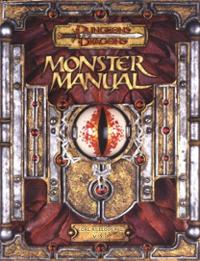
Monster Manual for Dungeons & Dragons 3rd Edition by Wizards of the Coast, 2000/2003; 266 pages of monsters.
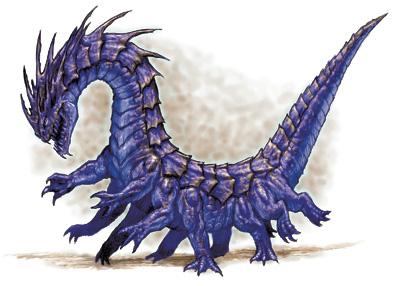
I am not going to lie, I love the Behir mostly because of the picture. Damn, this thing looks cool. A behir is a huge spiky purple snake with lots of small legs. While they are not particularly bright, they are still of somewhat human-like intelligence and able to talk. But like animals they are of neutral alignment, which means they shouldn’t be attacking everyone they encounter on sight, as an intelligent creature killing other intelligent creatures for food is almost always considered evil, no matter what particular interpretation of alignment you follow. Though that leaves the question, how do they interact with player characters? They probably would defend their home against intruders and keep anyone from stealing their treasures, but with a creature like this its hard to imagine why they would even have treasure in the first place. The most likely situation I can imagine for players to fight a behir would be the behir being in service to some other more powerful creature or NPC and guarding the entrances to their stronghold. But even then, given the behirs usual alignment and intelligence, talking might be a real option as well. As a giant worm, a behir has all the common abilities of such creatures in 3rd edition, as wrapping around a smaller creature and crushing it or swallowing it down in one go. It also has a lightning breath, but as it can be used only once per minute, it probably will use it only once in a fight. The behir is actually a pretty old creature that predates the Monster Manual by almost 20 years, but I’ve never really seen it used anywhere through all editions.
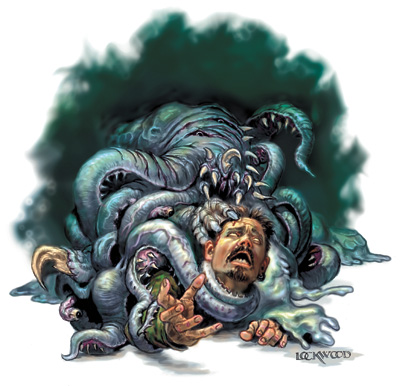
Chaos Beast, we meet again. It’s the Foaming Blasphemy from the Bestiary of the Hyborian Age. The Monster Manual actually predates the Bestiary by several years, but since the Bestiary usually only includes creatures from Conan stories, I think it’s a strong indication that this is where D&D got the idea from. The Bestiary then just copied the rules for the mechanical implementation that had already been written up for D&D. (Since the Conan d20 RPG is basically the same system; why invent the wheel twice?)
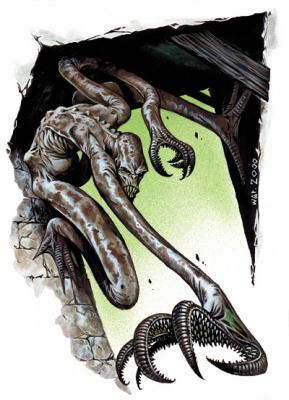
The Choker is a small creature of almost humanoid appearance, but its arms and legs are actually flexible tentacles. For creatures of their size and weight, chokers are amazingly strong and can climb like nobodies business. They are also very fast and can dart around and make multiple attacks at the same time, which in the way the game works could be very dangerous particularly at lower levels when player characters don’t have much flexibility in tactical combat. Chokers often try to hide above doorways and under the ceiling and are very well hidden for low-level monsters. Unsurprisingly, they use their tentacle arms and legs to grab victims and strangle them, but since they are meant for low level parties they actually deal only very little damage. I believe they are a new creature introduced in 3rd edition.
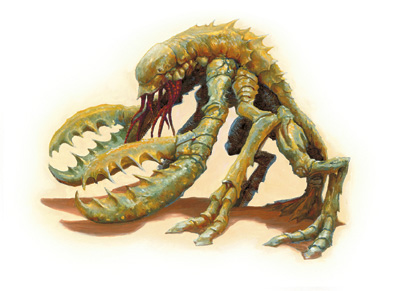
The Chuul is a creature that used to confuse me, but which I now actually really love quite a lot. It’s a completely new monster created for this book. A chuul is basically a very large intelligent lobster, though the description says it also has elements of insects and snakes, which are not really apparent in the picture. Its main attacks are its two huge claws which are nothing to laugh at, but it also can use them to grab an enemy it hits and keep a hold on it. In following rounds, it just needs to squeeze to deal more damage without having to make a new attack roll. 3rd edition loved it’s Improved Grab and Constrict abilities and there are dozens of monsters who have this. And it’s a cool idea in principle, but an extension of the horribly written grapple rules that are probably the most hated thing in the d20 system ever. In over a decade of running campaigns with this game, I think I never used this ability once, simply because I never really could get my head around it. Which sucks, because having a party member being held up in the air, flailing around, and trying to stab the monsters with a dagger while the others are trying to help him would be really cool. In addition to its claws, the chuul also has paralyzing tentacles at its mouth. It can’t attack with these normally, but use them against an enemy it grabed with a claw to take it out of the fight and go back to fighting the rest. Chuuls are a classic swamp monster, but they are also as intelligent as humans, which is a nice twist that might not be apparent at all during the first encounters. I also love the illustration, especially how you can’t really tell for sure where its face is. There are at least four possible positions for its eyes. When I went to make the Underworld monsters for my own Sword & Sorcery setting, I tried to make monsters that are based on insects and worms and also have no regular face. So of course there’s also one type among them which is heavily based on this picture. (Though not much else from this monster.)
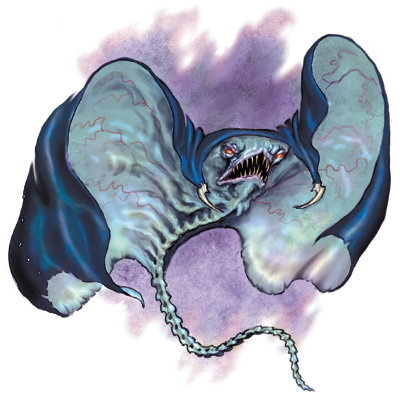
The Cloaker is an old monster, which I think goes back even to AD&D 1st edition. It started as one of those stupid “everything is trying to kill you” monsters and uses its two hooks near the head to grab on to a wall, which makes it look like a cloak hanging from a rack. Which will then jump you and try to kill you when you get too close. I think I might make a whole article about this particular class of early D&D monsters later on. There is a lot more of them and cloakers are really among the least stupid of these. The cloaker has fascinated me right from the begining, simply because of this really cool picture. I really love almost all of the Todd Lockwood and Sam Wood illustration from the very first 3rd edition books and I have no idea why they stopped getting hired later on. Wayne Reynolds is also cool, but using him so much made D&D look like Warcraft. Which is also a cool fantasy setting, but really not at all what Dungeons & Dragons should be like. But back to the cloaker: Cloakers are subterranean creatures reselmbling aquatic rays that have the ability to fly. They are highly intelligent, like many underdark monsters, but despite their fearsome appearance not actually evil. Which, like with the behir, raises the question how players would be expected to interact with them. Being intelligent, able to talk, and not generally cruel or hostile to other intelligent creatures, how would they react to PCs? Unfortunately, this monster manual never goes into this at all. It’s a book of combat stats, which sadly is very indicative to the whole approach WotC has to Dungeons & Dragons. Murderhobos: The Game. The abilities of the cloaker are quite interesting and unusual, though. They can groan in barely perceptible voices that still have various strange effects on the brains of other creatures, causing either great anxiety, total panic, nausea, or paralysis. Which I think is a really neat new approach to monster abilities. Some time ago it had been discovered that the human brain does indeed start to “glitch” when exposed to certain low-frequency vibrations. There is one particular frequency which very reliably makes people see ghost. And happens to sometimes be produced by aging ventilation fans. Instant haunting by the flick of a switch. Cloaker voices seems to work like that. Cloakers also have some strange relationship with shadows, which they can use to produce certain illusions. Running into cloakers that have not yet revealed themselves could be a really spooky encounter. And even when they do show themselves, you’re face to face with that nightmare shown above!
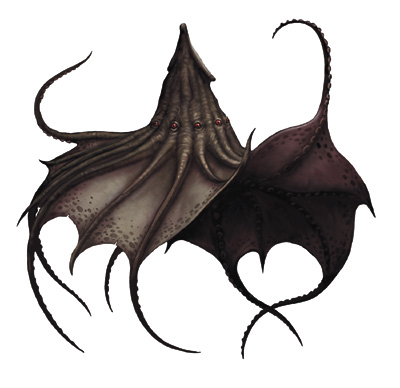
The Darkmantle reminds me of a couple of different monsters from AD&D, but I think this version did not appear before 3rd edition. It’s like a small kind of squid that lives underground and can fly. Of course it can. It uses the sucker on the base of its body to cling to the ceiling and then let is arms hang down to create the appearance of a stalagtite. It actually behaves very similar to chokers, waiting for a target to come nearby and then drop on it from above trying to strangle it. It of course also falls into the “everything is trying to kill you” category of monsters like the cloaker.
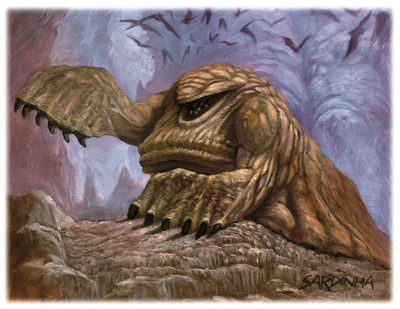
The Delver is another one of the really strange monsters from 3rd edition. To my knowledge it doesn’t have any tradition in D&D and was created specifically for this book. It’s a huge subterranean creature that digs itself through the ground, wanting nothing more but eat various kinds of minerals, while happening to have a pretty high intelligence above most humans. I always ignored it, having looked at it once and thought it was stupid. However, whoever wrote this thing did appear to have some idea what it would be for. Delvers are usually reclusive and don’t really want contact with anyone, but they really love to eat metal and can get quite crazy for it. Which of course sucks when you are mining valuable ore and a delver finds your mine. Sometimes they even attack people to eat their weapons and armor. They are not evil and very intelligent, but just have this huge craving for metal. So that’s clearly one interesting hook how to include them in a game. But unfortunately, it also seems to be the only thing you really can do with them. “We got this big fella in our mine who is eating all our iron. Please make him leave!” Once you did that adventure one time, the potential uses of the delver seem to be exhausted. The only other use I could think of would be to have dwarves or deep gnomes bribe a delver with metal to use as a siege engine to attack an enemy stronghold. Since its not evil, it could also be working for duergar or drow, but be very willing to switch sides if approached by the PCs. This is actually not a stupid or useless monster, but the book doesn’t really make a good job at explaining it. Given its abilities, this creature is much more interesting as something you should not fight. Sadly, this was not the path that D&D would take after 3rd edition was released, so I believe the delver never really saw any use.
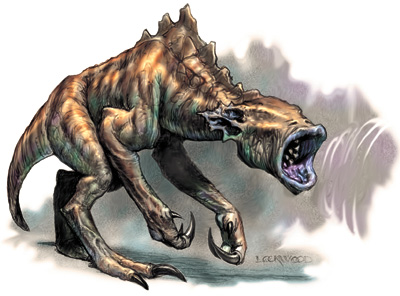
The Destrachan is another underground creature, because that’s where all the really weird critters live. It’s a big bipedial lizard somewhat similar in stature to a small hadrosaurus, but also predatory and completely blind. Being at home miles underground in the dark, destrachans don’t even have any eyes and percieve their environment entirely by sound like bats. Of couse they are also intelligent creatures, but these ones are actually plain evil. Yes! Finally some bastards who really need killing. Like the cloaker, a destrachan can use its voice not just for echolocation, but also as a weapon. The pressure waves from a destrachans throat can cause significant damage to muscles or organs, or alternatively paralyze nerves. As a third option, a destrachan can even shatter wood, metal, or stone that way. Naturally its very dificult to damage a destrachans hearing to make it unable to locate other creatures. And again, this Lookwood illustration looks really great. Actually, since this post has already turned into an unashamed soapbox a long time ago, lets talk some more about monster manual art. Leonaru at RPG.net is currently doing his own series on the 5th edition Monster Manual which also discusses the art. While the art in that book is pretty well done and serviceable and also looks pretty high quality at first, it really leaves a lot of people cold. Part of that is because of the boring poses in which the creatures are show, but what makes them particularly boring looking to me is the lack of colors and textures. Those creatures are usually uniformly brown or uniformly gray. This really cool looking Lockwood illustration, like the cloaker above, have a lot of texture and colors, and they just look amazing! It also helps that the two creatures are not just standing there, but seem to be in the middle of an attack, which makes them more dynamic and gives you an impression how it would be when the PCs are fighting with them. There isn’t really much to see, but its so much more interesting than something that looks like a biology textbook illustration.
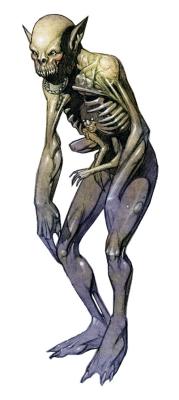
The Devourer is another older creature, which I believe is actually from Planescape. It’s an undead monster from another dimension and while mostly human shaped, its actually pretty huge, standing almost 3 meters tall. These things are really very dangerous and highly intelligent and have a number of spells like confusion, suggestion, ray of enfeeblement, and true seeing. Like any self-respecting high level undead, devourers can drain the life force of living creatures, but can do so even at a distance. The most distinguishing ability of devourers is to rip out another creatures soul and trap it inside its own ribcage. This soul serves as fuel for the devourers spells and will eventually become consumed. This is a seriously creepy creature. But like many monsters in this book, it suffers from lacking any explanation about what it wants and how it behaves. A high level monster with high intelligence and the ability to cast suggestion is not something that just jumps around the corner trying to eat you. So what does it do? This book doesn’t tell.
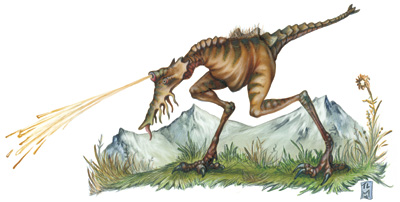
The Digester is a strong contender for the dumbest monster in this book, but much of that might be because of the illustration. It’s basically a deinonychus with a stupid looking head that spirts acid. I think I once saw these things mentioned in an adventure from Dungeon, but I’m not even sure about that. Lack of meaningful description of any kind makes this creature just meh.
